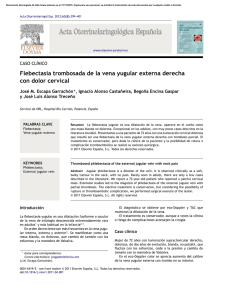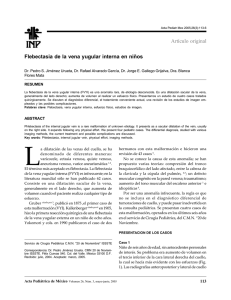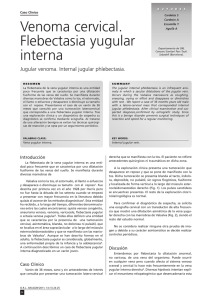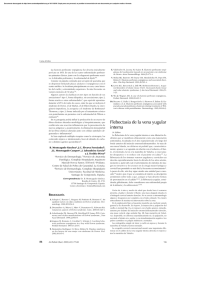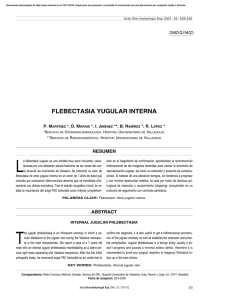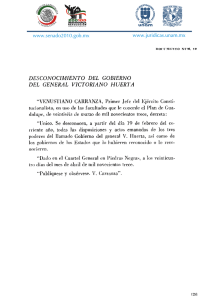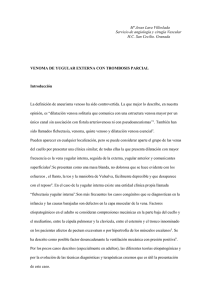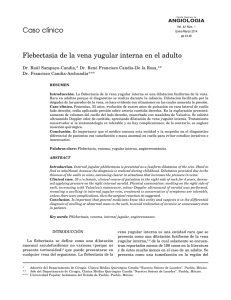Thrombosed Phlebectasia of the External Jugular Vein With Neck Pain
Anuncio
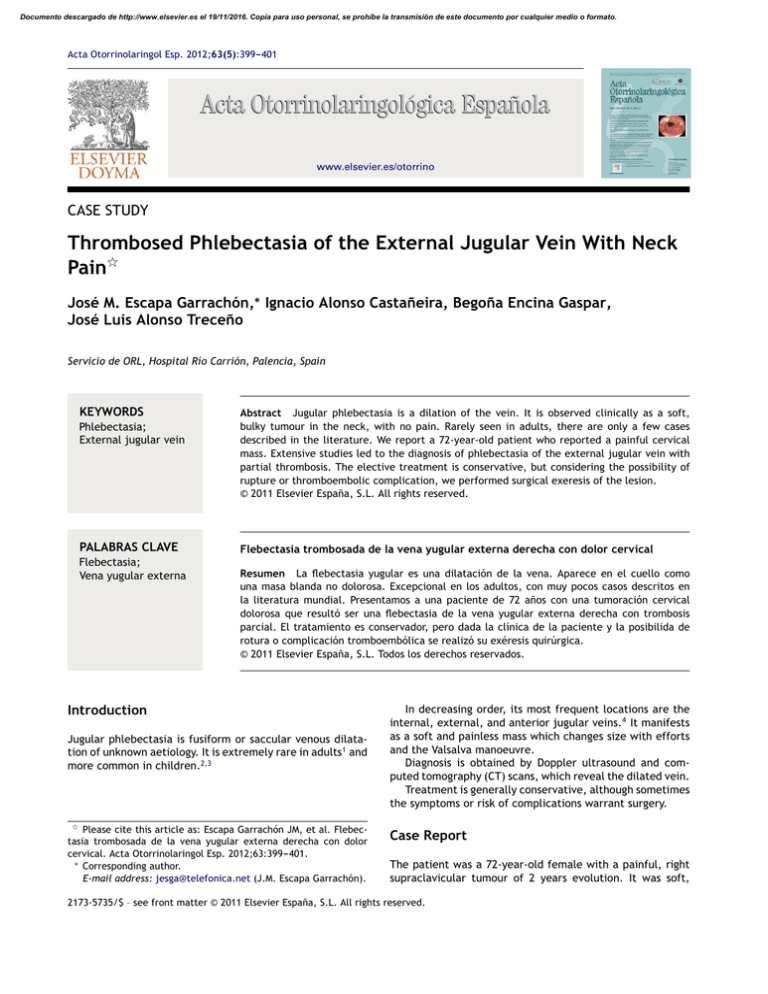
Documento descargado de http://www.elsevier.es el 19/11/2016. Copia para uso personal, se prohíbe la transmisión de este documento por cualquier medio o formato. Acta Otorrinolaringol Esp. 2012;63(5):399---401 www.elsevier.es/otorrino CASE STUDY Thrombosed Phlebectasia of the External Jugular Vein With Neck Pain夽 José M. Escapa Garrachón,∗ Ignacio Alonso Castañeira, Begoña Encina Gaspar, José Luis Alonso Treceño Servicio de ORL, Hospital Río Carrión, Palencia, Spain KEYWORDS Phlebectasia; External jugular vein PALABRAS CLAVE Flebectasia; Vena yugular externa Abstract Jugular phlebectasia is a dilation of the vein. It is observed clinically as a soft, bulky tumour in the neck, with no pain. Rarely seen in adults, there are only a few cases described in the literature. We report a 72-year-old patient who reported a painful cervical mass. Extensive studies led to the diagnosis of phlebectasia of the external jugular vein with partial thrombosis. The elective treatment is conservative, but considering the possibility of rupture or thromboembolic complication, we performed surgical exeresis of the lesion. © 2011 Elsevier España, S.L. All rights reserved. Flebectasia trombosada de la vena yugular externa derecha con dolor cervical Resumen La flebectasia yugular es una dilatación de la vena. Aparece en el cuello como una masa blanda no dolorosa. Excepcional en los adultos, con muy pocos casos descritos en la literatura mundial. Presentamos a una paciente de 72 años con una tumoración cervical dolorosa que resultó ser una flebectasia de la vena yugular externa derecha con trombosis parcial. El tratamiento es conservador, pero dada la clínica de la paciente y la posibilida de rotura o complicación tromboembólica se realizó su exéresis quirúrgica. © 2011 Elsevier España, S.L. Todos los derechos reservados. Introduction Jugular phlebectasia is fusiform or saccular venous dilatation of unknown aetiology. It is extremely rare in adults1 and more common in children.2,3 夽 Please cite this article as: Escapa Garrachón JM, et al. Flebectasia trombosada de la vena yugular externa derecha con dolor cervical. Acta Otorrinolaringol Esp. 2012;63:399---401. ∗ Corresponding author. E-mail address: [email protected] (J.M. Escapa Garrachón). In decreasing order, its most frequent locations are the internal, external, and anterior jugular veins.4 It manifests as a soft and painless mass which changes size with efforts and the Valsalva manoeuvre. Diagnosis is obtained by Doppler ultrasound and computed tomography (CT) scans, which reveal the dilated vein. Treatment is generally conservative, although sometimes the symptoms or risk of complications warrant surgery. Case Report The patient was a 72-year-old female with a painful, right supraclavicular tumour of 2 years evolution. It was soft, 2173-5735/$ – see front matter © 2011 Elsevier España, S.L. All rights reserved. Documento descargado de http://www.elsevier.es el 19/11/2016. Copia para uso personal, se prohíbe la transmisión de este documento por cualquier medio o formato. 400 J.M. Escapa Garrachón et al. Figure 1 (A) Axial, B-mode ultrasound image of the right, external jugular vein, showing its increased calibre, as well as an echogenic thrombus, occupying the lumen subtotally. (B) Axial, cervical CT scan with contrast, showing a dilated, right, external jugular vein with a large, central thrombus and permeable marginal lumen. (C) Oblique, sagittal reconstruction, showing 2 afferents to the thrombosed phlebectasia corresponding to the external jugular vein and an occipital branch. Figure 2 (A and B) Images of the excision of right, external jugular phlebectasia. (C) Surgical specimen. non-pulsatile, fluctuated with efforts, yielded to pressure and changed size with the Valsalva manoeuvre. A colour Doppler revealed the increased calibre of the external jugular vein and a thrombus in its interior. The CT scan showed a varicose dilatation at the expense of the right external jugular vein, approximately 4.5 cm×3.5 cm×3 cm, with a large central thrombus and a permeable marginal lumen, as well as a tapered efferent portion and normal afferent portion. The 3D reconstruction showed a second afferent vein (Fig. 1). We performed exeresis and ligation of the venous connections, confirming the 2 afferents to thrombosed phlebectasia, which corresponded to the external jugular vein and an occipital branch. Pathological anatomy confirmed the diagnosis of external jugular phlebectasia, with partially thrombosed material (Fig. 2). The patient is currently without evidence of disease and cervical pain has disappeared. Discussion There are different hypotheses to explain the origin of venous ectasias in general. They may be associated with congenital defects of the muscular wall of the vein, mechanical obstructions in the lower part of the neck and mediastinum, compression of the jugular vein between the clavicle and the top of the right lung and increased scalene muscle tone.4---6 This entity should be suspected upon observation of a supraclavicular neck mass which increases in size with efforts and the Valsalva manoeuvre, generally asymptomatic, although in some rare occasions it may cause pain, as in our case. It may also appear at the tongue base.7 Colour Doppler ultrasound is the method of choice to determine the nature of the tumour and differentiate dilation of the jugular vein from other vascular and non-vascular dilations and cystic neck malformations.8 The study should be completed by a CT scan and 3D reconstruction. Its differential diagnosis should include external laryngocele, arteriovenous malformations, parapharyngeal and branchial cysts.9 Treatment should be conservative, unless the symptoms or risk of fracture advise surgery. Jugular vein thrombosis may cause venous thromboembolism in patients with phlebectasia,10 so surgical treatment should be considered.3 Conflict of Interests The authors have no conflict of interests to declare. Documento descargado de http://www.elsevier.es el 19/11/2016. Copia para uso personal, se prohíbe la transmisión de este documento por cualquier medio o formato. Thrombosed Phlebectasia of the External Jugular Vein With Neck Pain References 1. Uzun C, Taskinalp O, Koten M, Adali MK, Karasalihoglu AR, Pekindil G. Phlebectasia of left anterior jugular vein. J Laryngol Otol. 1999;113:858---60. 2. Pul N, Pul M. External jugular phlebectasia in children. Eur J Pediatr. 1995;15:275---6. 3. Al-Dousary S. Internal jugular phlebectasia. Int J Pediatr Otorhinolaryngol. 1997;38:273---80. 4. Natarajan B, Johnstone A, Sheikh S, Palmer O, Madhavan KN. Unilateral anterior jugular phlebectasia. J Laryngol Otol. 1994;108:352---3. 5. Sander S, Elicevik M, Unal M, Vural O. Jugular phlebectasia in children --- it is rare or ignored? J Pediatr Surg. 1999;34:1829---32. 401 6. Paleri V, Gopalakrishnan S. Jugular phlebectasia: theory of pathogenesis and review of literature. Int J Pediatr Otorhinolaryngol. 2001;57:155---9. 7. Stofman GM, Schneidermann T, Sasson HN, Younai S, Narayanan K. Aberrant external jugular vein phlebectasia with tongue pain. Am J Otolaryngol. 1997;18:148---50. 8. Hussein A, Trowitzsch E. Jugular phlebectasia in children. Eur J Pediatr. 1996;155:67. 9. Nwako FA, Agugua NE, Udeh CA, Osuorji RI. Jugular phlebectasia. J Pediatr Surg. 1989;24:303---5. 10. Zohar Y, Ben Tovim R, Talmi YP. Phlebectasia of the jugular system. J Craniomaxillofac Surg. 1989;17: 96---8.
